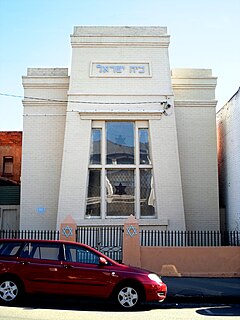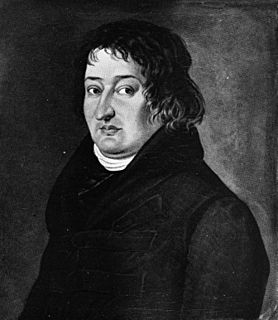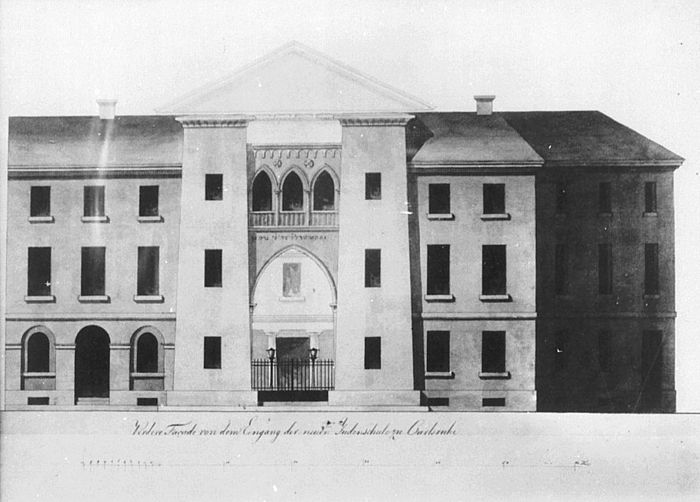
Karlsruhe is the second-largest city of the German federal state of Baden-Württemberg after its capital of Stuttgart, and its 313,092 inhabitants make it the 21st largest city of Germany. On the right bank of the Rhine, the city lies near the French-German border, between the Mannheim/Ludwigshafen conurbation to the north, and the Strasbourg/Kehl conurbation to the south. It is the largest city of Baden, a historic region named after Hohenbaden Castle in the city of Baden-Baden. Karlsruhe is also the largest city in the South Franconian dialect area, the only other larger city in that area being Heilbronn. The city is the seat of the Federal Constitutional Court (Bundesverfassungsgericht), as well as of the Federal Court of Justice (Bundesgerichtshof) and the Public Prosecutor General of the Federal Court of Justice.

Egyptian revival is an architectural style that uses the motifs and imagery of ancient Egypt. It is attributed generally to the public awareness of ancient Egyptian monuments generated by Napoleon's conquest of Egypt and Admiral Nelson's defeat of the French Navy at the Battle of the Nile in 1798. The size and monumentality of the façades 'discovered' during his adventure cement the hold of Egyptian aesthetics on the Parisian elite. Napoleon took a scientific expedition with him to Egypt. Publication of the expedition's work, the Description de l'Égypte, began in 1809 and was published as a series through 1826. However, works of art and architecture in the Egyptian style had been made or built occasionally on the European continent and the British Isles since the time of the Renaissance.
The year 1826 in architecture involved some significant architectural events and new buildings.

Synagogue architecture often follows styles in vogue at the place and time of construction. There is no set blueprint for synagogues and the architectural shapes and interior designs of synagogues vary greatly. According to tradition, the Divine Presence (Shekhinah) can be found wherever there is a minyan, a quorum, of ten. A synagogue always contains an ark, called aron ha-kodesh by Ashkenazim and hekhal by Sephardim, where the Torah scrolls are kept.
The year 1798 in architecture involved some significant events.

Congregation Mikveh Israel, "Holy Community of the Hope of Israel", is a synagogue in Philadelphia, Pennsylvania that traces its history to 1740. Mikveh Israel is a Spanish and Portuguese synagogue that follows the rite of the Amsterdam esnoga. It is the oldest synagogue in Philadelphia, and among the oldest in the United States.

The Great Synagogue of London was, for centuries, the centre of Ashkenazi synagogue and Jewish life in London. Built north of Aldgate in the 17th century, it was destroyed during World War II, in the Blitz.

The Great Synagogue is the main synagogue of the Jewish community in Copenhagen, Denmark. The synagogue is defined by its unique architecture around the Ark. During the first half of the 19th century, synagogues continued to be built in the classical tradition, but there began to be a revival of Greek and Roman architecture. The Great Synagogue in Copenhagen is one of a few synagogues of its period to use Egyptian elements in the columns, ceiling and cornice over the ark.

The Great Synagogue is a large heritage-listed synagogue located at 187a Elizabeth Street in the Sydney central business district, in the City of Sydney local government area of New South Wales, Australia. Sited opposite Hyde Park, the synagogue extends to Castlereagh Street. It was designed by Thomas Rowe and built from 1874 to 1878, with stonework by Aaron Loveridge. The synagogue was added to the New South Wales State Heritage Register on 10 September 2004. The building is also listed on the Register of the National Estate.
Diana Muir, also known as Diana Muir Appelbaum, is a Newton, Massachusetts historian best known for her 2000 book Reflections in Bullough's Pond, a history of the impact of human activity on the New England ecosystem.

The Badisches Staatstheater Karlsruhe is a theatre and opera house in Karlsruhe, Germany. It has existed in its present form and place at Ettlinger Tor since 1975. Achim Thorwald became the Intendant in summer 2002 and held that post until the end of the 2010/11 season. Peter Spuhler succeeded him at the beginning of the 2011/12 season and continues to serve in that post.

Congregation Ramath Orah is an Orthodox synagogue located in Manhattan's Upper West Side, close to Columbia University. It occupies a neo-Georgian building on West 110th Street, originally built in 1921 as the first stage of a large West Side Unitarian Church.

The Hobart Synagogue is a heritage-listed synagogue located in 59 Argyle Street, Hobart, Tasmania, Australia. The synagogue is the oldest synagogue building in Australia and is a rare example of the Egyptian Revival style of synagogue architecture. The Egyptian Revival building was constructed in 1845. The trapezoidal shape of the windows and the columns with lotus capitals are characteristic of the Egyptian Revival style. Currently the Hobart Synagogue has regular services by both Orthodox and Progressive groups.

The Old Synagogue in Canterbury is considered to be the best example of an Egyptian Revival synagogue.

The Launceston Synagogue is a heritage-listed building located in St. John's Street, Launceston, Tasmania, Australia, that served as a synagogue from 1846 until 1871, and again during the c. 1930s until its closure in 1961 and reopened in 1984.
James Hume (1798–1868) was one of the first architects in Sydney, Australia.

Friedrich Weinbrenner was a German architect and city planner admired for his mastery of classical style.
The Tempel Synagogue was a Jewish synagogue in Przemyśl, Poland.

The Karlsruhe Pyramid is a pyramid made of red sandstone, located in the centre of the market square of Karlsruhe, Germany. It was erected in the years 1823–1825 over the vault of the city's founder, Margrave Charles III William (1679–1738). The pyramid is regarded as Karlsruhe's second emblem, the city's absolutist layout in the shape of a folding fan being the first.

The New Castle is a nineteenth century palace in Hechingen in Germany. It served as the city residence for princes of the House of Hohenzollern-Hechingen.
















